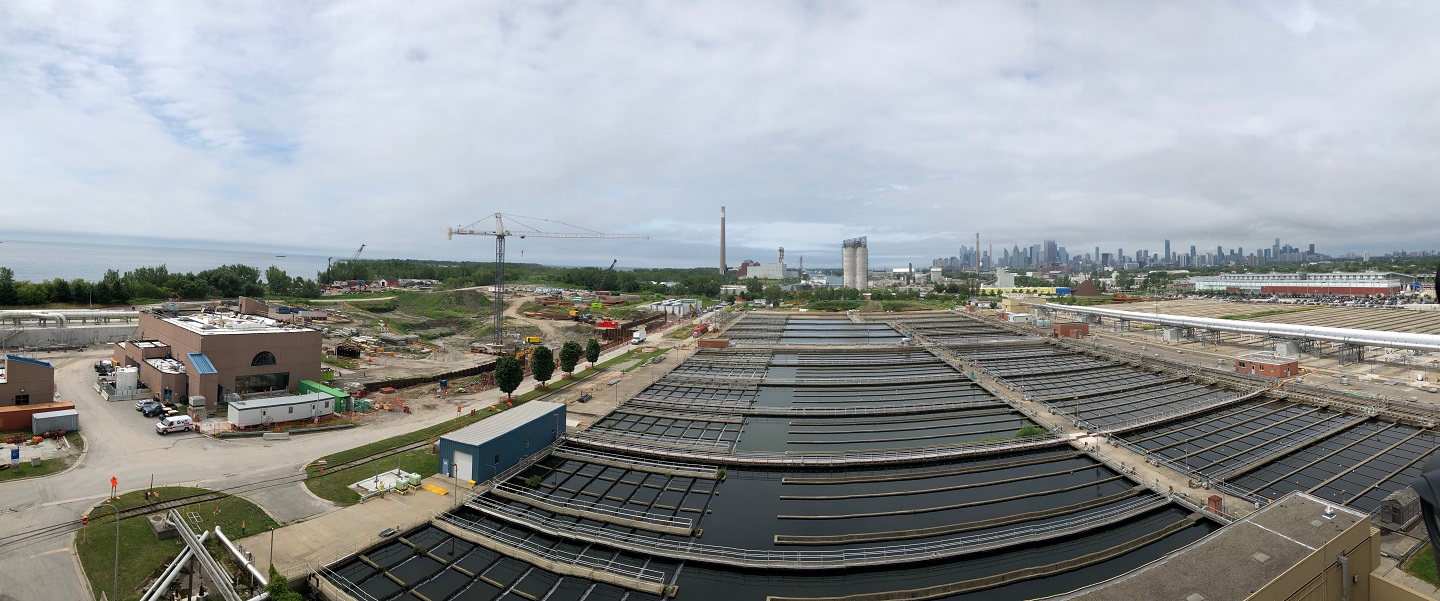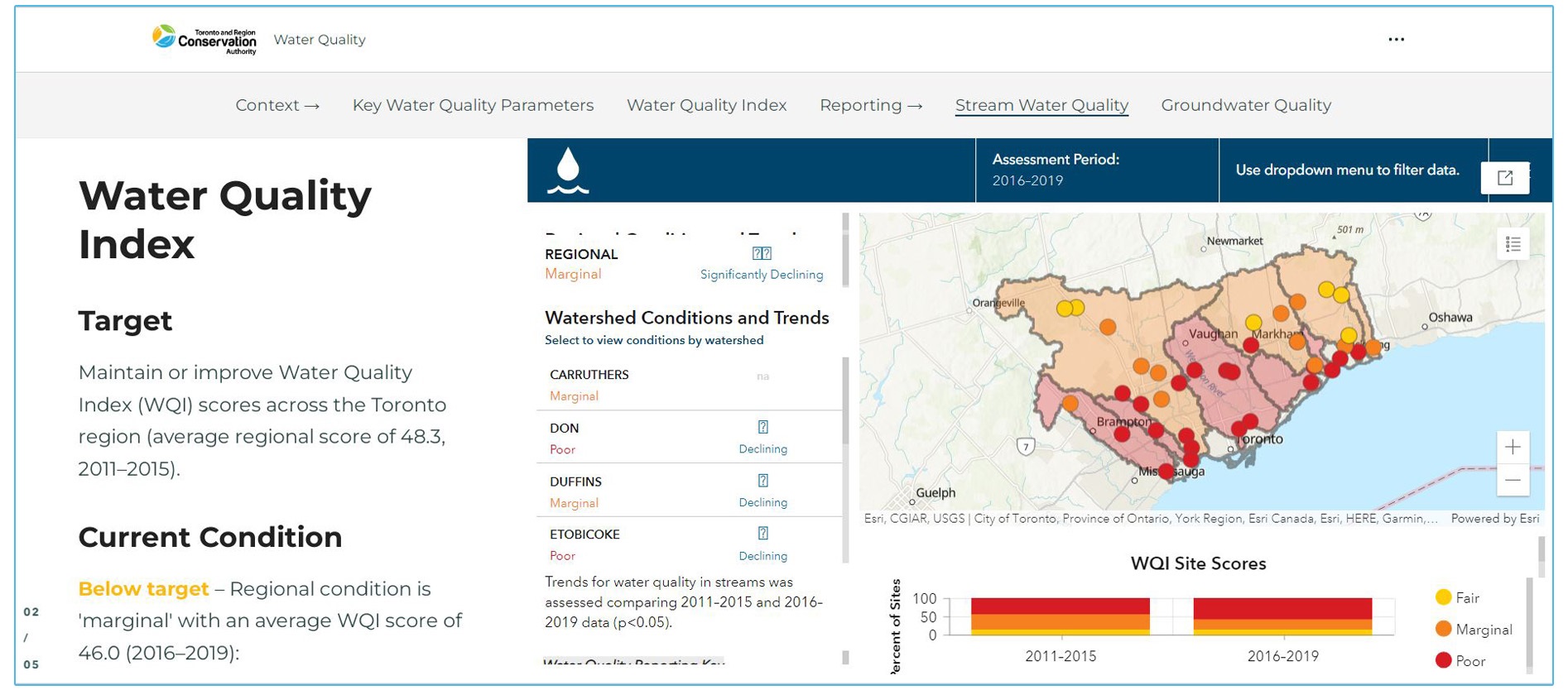But Phosphorous and Undesirable Algae Remains a Complex Issue
Phosphorus is a naturally occurring, essential nutrient for living organisms. However, elevated concentrations of phosphorus in our lakes, rivers, and streams can lead to an unbalanced aquatic ecosystem, including excessive plant and algae growth.
This process — called eutrophication — may lead to algae blooms, which in extreme cases can decrease oxygen levels in the waters of a lake, and cause fish deaths.
Phosphorous concentrations collected in water samples in the 1970s and early 1980s frequently exceeded the Provincial Water Quality Objective (PWQO) of 20 µg/l.
Eutrophication or Undesirable Algae was identified as a Beneficial Use Impairment (BUI #8) in the Toronto and Region Area of Concern (AOC), on the grounds that elevated concentrations of phosphorus impact the beneficial use of the waterfront by Toronto residents.
So what causes elevated nutrient levels? The major culprits are:
- Municipal wastewater and stormwater runoff
- Runoff from agriculture
- Discharges from local industry
What We’ve Done, and What We’re Doing
Significant progress has been made to address eutrophication or nuisance algae since the designation of Toronto and Region as an AOC.
The removal of phosphates from detergents and the initiation of phosphorus removal in municipal wastewater treatment plants led to a decline in phosphorus concentrations and algal biomass from the late 1970s to the present. These two programs enabled Toronto and Region to achieve initial International Joint Commission (IJC) total phosphorus loading objectives for Lake Ontario in the 1990s.
Continuing improvements in sewage treatment and stormwater infrastructure — including wet weather flow management projects and dry weather flow reduction measures — have contributed to a decline in phosphorus concentrations along the waterfront.
Toronto and Region is Canada’s largest urban area, with a population that is growing rapidly. As a result, phosphorus remains an important environmental concern affecting Toronto’s waterfront and Lake Ontario.
Phosphorus loads from the watersheds remain high, and the Toronto and Region Remedial Action Plan remains focused on reducing these loads.
The City of Toronto continues to implement its Wet Weather Flow Master Plan, a major component of which is the Don River and Central Waterfront Combined Sewer Overflow project. This $3 billion initiative aims to improve water quality in the Lower Don River, Taylor Massey Creek, and Toronto’s Inner Harbour by keeping combined sewer overflows out of these waterways.
It includes key infrastructure projects that provide redundancy in the wastewater collection system, improves processes at the Ashbridges Bay Treatment Plant (pictured below), adds a new High Rate Treatment system, and advances the state of good repair objectives.
 Toronto’s Ashbridges Bay Wastewater Treatment Plant is being upgraded to meet high water quality standards.
Toronto’s Ashbridges Bay Wastewater Treatment Plant is being upgraded to meet high water quality standards.
Phosphorus Levels Are Within the Acceptable Range — But Not For the Reasons You Might Think
Thanks to much of the work that has taken place, Toronto’s waterfront is generally mesotrophic — meaning that it is characterized by medium levels of nutrients and generally clear water. During dry weather periods, phosphorus levels along the waterfront frequently meet the Provincial Water Quality Guidelines.
However, phosphorus concentrations in the watersheds remain elevated above provincial guidelines, and during precipitation events significant loads of phosphorus are discharged to Lake Ontario. Elevated concentrations of phosphorus on the waterfront allow algal growth to persist along the western waterfront.
Nevertheless, despite these continual nutrient inputs, phosphorus does not accumulate, thanks to regular physical mixing and flushing of the Toronto inner harbour.
The frequent flushing of the inner harbour, along with wind-driven circulation and frequent upwelling events in Lake Ontario, keeps phosphorus from building up along most of the Toronto waterfront (Bogden et al., 2018; Snodgrass et al., 2018). All the same, it remains important to continue to address the sources of phosphorus within the AOC, as elevated inputs from the area remain large and can manifest in algal blooms.
Cladophora Growth Along the Western Waterfront
Excess Cladophora (algae) growth continues to be observed along the western waterfront of the Toronto and Region AOC.
Colonization by invasive zebra and quagga mussels in the 1990s has led to a concentration of phosphorus near the lake bed, and resulted in increased light penetration to the sediment which has led to a resurgence of Cladophora growth on a regional scale.
Due to the ubiquitousness of the benthic algae Cladophora in Lake Ontario, the issue is being addressed at the lake-wide scale, through initiatives such as the Lake Ontario Action and Management Plan (LaMP).
GO DEEPER!
Explore TRCA’s Watershed and Ecosystems Reporting Hub to learn more about water quality within the Toronto and Region AOC watersheds.
Select the image below to visit the reporting hub.
Chapra S.C., D. M. Dolan, and A. Dove (2016) Mass-balance modeling framework for simulating and managing long-term water quality for the lower Great Lakes Journal of Great Lakes Research 38 (2016) Article In Press. 8 pp: http://dx.doi.org/10.1016/j.jglr.2016.04.008
Hecky, R.E., Smith, R.E.H., Barton, D.R., Guildford, S.J., Taylor, W.D., Charlton, M.N., Howell, E.T., 2004. The nearshore phosphorus shunt: A consequence of ecosystem engineering by dreissenids in the Laurentian Great Lakes. Can. J. Fish. Aquat. Sci. 61, 1285–1293.
Hlevca, Bogdan, Mathew Wells, Liset Cruz Font, Susan Doka, Rick Portiss, Meg St John, and Steven Cooke (2018). Water circulation in Toronto Harbour. Aquatic Ecosystem Health & Management. 21. 1-21. 10.1080/14634988.2018.1500059. Howell, E.T, S. C. Dahmer, K. M. Chomicki, N. Benoit, D. Boyd & G. S. Bowen (2018) Monitoring water quality on the central Toronto waterfront: Perspectives on addressing spatiotemporal variability, Aquatic Ecosystem Health & Management, 21:3, 255 – 267, DOI: 10.1080/14634988.2018.1500060
Kidd, J. Within Reach: 2015 Toronto and Region Remedial Action Plan Progress Report. https://torontorap.ca/app/uploads/2016/10/2015-RAP-Progress-Report.pdf
Snodgrass William J., Ray Dewey, Michael D’Andrea, Rob Bishop and Jian Lei. (2018) “Forecasting Receiving Water Response to Alternative Control Levels for Combined Sewer Overflows discharging to Toronto’s Inner Harbour”. Aquatic Ecosystem Health and Management 21 (3) pp 245-254, DOI: 10.1080/14634988.2018.1507528
Toronto and Region Remedial Action Plan. 2015. Preliminary Assessment of the Eutrophication or Undesirable Algae Beneficial Use Impairment (BUI) Along the Toronto and Region Waterfront. https://torontorap.ca/app/uploads/2013/01/Toronto-and-Region-AOC-Preliminary-Eutrophication-Assessment.pdf

